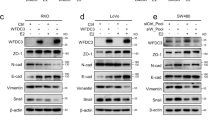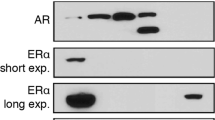Abstract
Although there is growing evidence that estrogens promote tumor progression in epithelial ovarian cancer, the molecular mechanisms accounting for this are still unclear. Selective estrogen receptor modulators (SERMs) mimic estrogen action in certain tissues while opposing it in others. The molecular mechanisms of the effects of SERMs such as raloxifene on the tumor progression of epithelial ovarian cancer are also still unclear. Here, we show that various genomic actions of estrogen differ from those of raloxifene in human ovarian cancer cell lines expressing estrogen receptor α (ERα). 17β-Estradiol (E2) induced the gene expression of c-Myc and IGF-1 and increased the binding of ERα to the AP1 site of the promoters of c-Myc and IGF-1. ERα silencing abolished the E2-stimulated c-Myc expression. E2 induced the recruitment of co-activators such as SRC-1, SRC-3 and CBP to the promoters of c-Myc and IGF-1, and SRC-1 silencing abolished both the E2-stimulated c-Myc expression and cell-cycle progression. In contrast, although raloxifene increased the binding of ERα to the AP1 site of the promoters of c-Myc and IGF-1, raloxifene had no effect on the gene expression of c-Myc or IGF-1. Raloxifene induced the recruitment of co-repressors such as HDAC2, N-CoR and SMRT to the promoter of IGF-1. Thus, the difference between the genomic actions exerted by estrogen and raloxifene in human ovarian cancer cell lines expressing ERα appear to be dependent on the recruitment of co-regulators.
This is a preview of subscription content, access via your institution
Access options
Subscribe to this journal
Receive 50 print issues and online access
$259.00 per year
only $5.18 per issue
Buy this article
- Purchase on Springer Link
- Instant access to full article PDF
Prices may be subject to local taxes which are calculated during checkout










Similar content being viewed by others
References
Anderson GL, Limacher M, Assaf AR, Bassford T, Beresford SA, Black H et al. (2004). Effects of conjugated equine estrogen in postmenopausal women with hysterectomy: the Women's Health Initiative randomized controlled trial. JAMA 291: 1701–1712.
Bardin A, Hoffmann P, Boulle N, Katsaros D, Vignon F, Pujol P et al. (2004). Involvement of estrogen receptor beta in ovarian carcinogenesis. Cancer Res 64: 5861–5869.
Berns EM, Klijn JG, Henzen-Logmans SC, Rodenburg CJ, van der Burg ME, Foekens JA . (1992). Receptors for hormones and growth factors and (onco)-gene amplification in human ovarian cancer. Int J Cancer 52: 218–224.
Cauley JA, Norton L, Lippman ME, Eckert S, Krueger KA, Purdie DW et al. (2001). Continued breast cancer risk reduction in postmenopausal women treated with raloxifene: 4-year results from the MORE trial. Multiple outcomes of raloxifene evaluation. Breast Cancer Res Treat 65: 125–134.
Celano P, Berchtold C, Casero R . (1989). A simplification of the nuclear run-off transcription assay. Biotechniques 7: 942–944.
Chow SN, Chien CH, Chen CT . (1996). Molecular biology of human ovarian cancer. Int Surg 81: 152–157.
Cummings SR, Eckert S, Krueger KA, Grady D, Powles TJ, Cauley JA et al. (1999). The effect of raloxifene on risk of breast cancer in postmenopausal women: results from the MORE randomized trial. Multiple Outcomes of Raloxifene Evaluation. JAMA 281: 2189–2197.
Cunat S, Hoffmann P, Pujol P . (2004). Estrogens and epithelial ovarian cancer. Gynecol Oncol 94: 25–32.
Delmas PD, Bjarnason NH, Mitlak BH, Ravoux AC, Shah AS, Huster WJ et al. (1997). Effects of raloxifene on bone mineral density, serum cholesterol concentrations, and uterine endometrium in postmenopausal women. N Engl J Med 337: 1641–1647.
Dubik D, Shiu RP . (1992). Mechanism of estrogen activation of c-myc oncogene expression. Oncogene 7: 1587–1594.
Girault I, Lerebours F, Amarir S, Tozlu S, Tubiana-Hulin M, Lidereau R et al. (2003). Expression analysis of estrogen receptor alpha coregulators in breast carcinoma: evidence that NCOR1 expression is predictive of the response to tamoxifen. Clin Cancer Res 9: 1259–1266.
Green S, Walter P, Greene G, Krust A, Goffin C, Jensen E et al. (1986). Cloning of the human oestrogen receptor cDNA. J Steroid Biochem 24: 77–83.
Hamilton TC, Winker MA, Louie KG, Batist G, Behrens BC, Tsuruo T et al. (1985). Augmentation of adriamycin, melphalan, and cisplatin cytotoxicity in drug-resistant and -sensitive human ovarian carcinoma cell lines by buthionine sulfoximine mediated glutathione depletion. Biochem Pharmacol 34: 2583–2586.
Hayakawa J, Mittal S, Wang Y, Korkmaz KS, Adamson E, English C et al. (2004). Identification of promoters bound by c-Jun/ATF2 during rapid large-scale gene activation following genotoxic stress. Mol Cell 16: 521–535.
Hewitt SC, Deroo BJ, Korach KS . (2005). Signal transduction. A new mediator for an old hormone? Science 307: 1572–1573.
Hisamoto K, Ohmichi M, Kanda Y, Adachi K, Nishio Y, Hayakawa J et al. (2001a). Induction of endothelial nitric-oxide synthase phosphorylation by the raloxifene analog LY117018 is differentially mediated by Akt and extracellular signal-regulated protein kinase in vascular endothelial cells. J Biol Chem 276: 47642–47649.
Hisamoto K, Ohmichi M, Kurachi H, Hayakawa J, Kanda Y, Nishio Y et al. (2001b). Estrogen induces the Akt-dependent activation of endothelial nitric-oxide synthase in vascular endothelial cells. J Biol Chem 276: 3459–3467.
Hussein-Fikret S, Fuller PJ . (2005). Expression of nuclear receptor coregulators in ovarian stromal and epithelial tumours. Mol Cell Endocrinol 229: 149–160.
Kawagoe J, Ohmichi M, Takahashi T, Ohshima C, Mabuchi S, Takahashi K et al. (2003). Raloxifene inhibits estrogen-induced up-regulation of telomerase activity in a human breast cancer cell line. J Biol Chem 278: 43363–43372.
Keeton EK, Brown M . (2005). Cell cycle progression stimulated by tamoxifen-bound estrogen receptor-alpha and promoter-specific effects in breast cancer cells deficient in N-CoR and SMRT. Mol Endocrinol 19: 1543–1554.
Kimura A, Ohmichi M, Kawagoe J, Kyo S, Mabuchi S, Takahashi T et al. (2004). Induction of hTERT expression and phosphorylation by estrogen via Akt cascade in human ovarian cancer cell lines. Oncogene 23: 4505–4515.
Krystal G, Birrer M, Way J, Nau M, Sausville E, Thompson C et al. (1988). Multiple mechanisms for transcriptional regulation of the myc gene family in small-cell lung cancer. Mol Cell Biol 8: 3373–3381.
Lacey Jr JV, Mink PJ, Lubin JH, Sherman ME, Troisi R, Hartge P et al. (2002). Menopausal hormone replacement therapy and risk of ovarian cancer. JAMA 288: 334–341.
Mabuchi S, Ohmichi M, Kimura A, Ikebuchi Y, Hisamoto K, Arimoto-Ishida E et al. (2004a). Tamoxifen inhibits cell proliferation via mitogen-activated protein kinase cascades in human ovarian cancer cell lines in a manner not dependent on the expression of estrogen receptor or the sensitivity to cisplatin. Endocrinology 145: 1302–1313.
Mabuchi S, Ohmichi M, Kimura A, Nishio Y, Arimoto-Ishida E, Yada-Hashimoto N et al. (2004b). Estrogen inhibits paclitaxel-induced apoptosis via the phosphorylation of apoptosis signal-regulating kinase 1 in human ovarian cancer cell lines. Endocrinology 145: 49–58.
Mawson A, Lai A, Carroll JS, Sergio CM, Mitchell CJ, Sarcevic B . (2005). Estrogen and insulin/IGF-1 cooperatively stimulate cell cycle progression in MCF-7 breast cancer cells through differential regulation of c-Myc and cyclin D1. Mol Cell Endocrinol 229: 161–173.
Murphy LJ . (1991). Estrogen induction of insulin-like growth factors and myc proto-oncogene expression in the uterus. J Steroid Biochem Mol Biol 40: 223–230.
Neven P, Goldstein SR, Ciaccia AV, Zhou L, Silfen SL, Muram D . (2002). The effect of raloxifene on the incidence of ovarian cancer in postmenopausal women. Gynecol Oncol 85: 388–390.
Oishi A, Ohmichi M, Takahashi K, Takahashi T, Mori-Abe A, Kawagoe J et al. (2004). Medroxyprogesterone acetate attenuates estrogen-induced nitric oxide production in human umbilical vein endothelial cells. Biochem Biophys Res Commun 324: 193–198.
Rao BR, Slotman BJ . (1991). Endocrine factors in common epithelial ovarian cancer. Endocr Rev 12: 14–26.
Revankar CM, Cimino DF, Sklar LA, Arterburn JB, Prossnitz ER . (2005). A transmembrane intracellular estrogen receptor mediates rapid cell signaling. Science 307: 1625–1630.
Rossouw JE, Anderson GL, Prentice RL, Caan B . (2002). Risks and benefits of estrogen plus progestin in healthy postmenopausal women: principal results From the Women's Health Initiative randomized controlled trial. JAMA 288: 321–333.
Shang Y, Brown M . (2002). Molecular determinants for the tissue specificity of SERMs. Science 295: 2465–2468.
Umayahara Y, Kawamori R, Watada H, Imano E, Iwama N, Morishima T et al. (1994). Estrogen regulation of the insulin-like growth factor I gene transcription involves an AP-1 enhancer. J Biol Chem 269: 16433–16442.
van Dam PA, Vergote IB, Lowe DG, Watson JV, van Damme P, van der Auwera JC et al. (1994). Expression of c-erbB-2, c-myc, and c-ras oncoproteins, insulin-like growth factor receptor I, and epidermal growth factor receptor in ovarian carcinoma. J Clin Pathol 47: 914–919.
Walsh BW, Kuller LH, Wild RA, Paul S, Farmer M, Lawrence JB et al. (1998). Effects of raloxifene on serum lipids and coagulation factors in healthy postmenopausal women. JAMA 279: 1445–1451.
Webb P, Valentine C, Nguyen P, Price Jr RH, Marimuthu A, West BL et al. (2003). ERbeta binds N-CoR in the presence of estrogens via an LXXLL-like motif in the N-CoR C-terminus. Nucl Recept 1: 4.
Weiss NS, Rossing MA . (2001). Oestrogen-replacement therapy and risk of ovarian cancer. Lancet 358: 438.
Acknowledgements
We are grateful to Ayako Okamura and Tomoko Iwaki for technical and secretarial assistance.
Author information
Authors and Affiliations
Corresponding author
Additional information
Supplementary Information accompanies the paper on the Oncogene website (http://www.nature.com/onc).
Supplementary information
Rights and permissions
About this article
Cite this article
Sasaki, H., Hayakawa, J., Terai, Y. et al. Difference between genomic actions of estrogen versus raloxifene in human ovarian cancer cell lines. Oncogene 27, 2737–2745 (2008). https://doi.org/10.1038/sj.onc.1210926
Received:
Revised:
Accepted:
Published:
Issue Date:
DOI: https://doi.org/10.1038/sj.onc.1210926
Keywords
This article is cited by
-
The multifaceted therapeutic value of targeting steroid receptor coactivator-1 in tumorigenesis
Cell & Bioscience (2024)
-
Nuclear receptor co-repressor NCOR2 and its relation to GPER with prognostic impact in ovarian cancer
Journal of Cancer Research and Clinical Oncology (2023)
-
The Role of Cow’s Milk Consumption in Breast Cancer Initiation and Progression
Current Nutrition Reports (2023)
-
BRCA1 negatively regulates IGF-1 expression through an estrogen-responsive element-like site
Cell Death & Disease (2012)
-
A potential estrogen mimetic effect of a bis(ethyl)polyamine analogue on estrogen receptor positive MCF-7 breast cancer cells
Amino Acids (2012)



